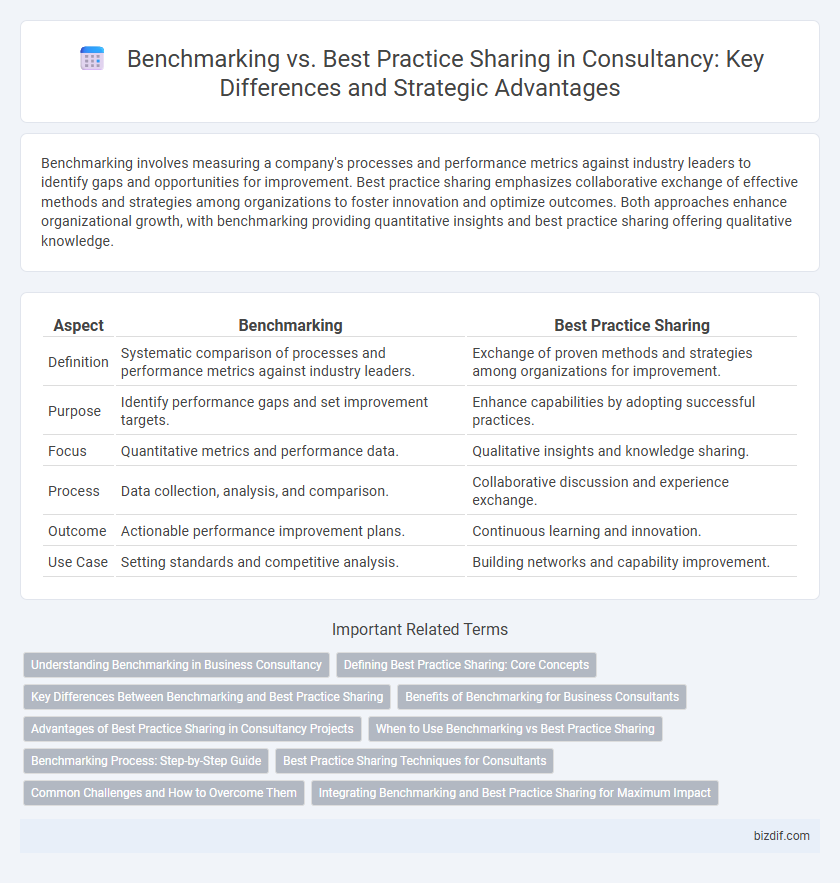Benchmarking involves measuring a company's processes and performance metrics against industry leaders to identify gaps and opportunities for improvement. Best practice sharing emphasizes collaborative exchange of effective methods and strategies among organizations to foster innovation and optimize outcomes. Both approaches enhance organizational growth, with benchmarking providing quantitative insights and best practice sharing offering qualitative knowledge.
Table of Comparison
| Aspect | Benchmarking | Best Practice Sharing |
|---|---|---|
| Definition | Systematic comparison of processes and performance metrics against industry leaders. | Exchange of proven methods and strategies among organizations for improvement. |
| Purpose | Identify performance gaps and set improvement targets. | Enhance capabilities by adopting successful practices. |
| Focus | Quantitative metrics and performance data. | Qualitative insights and knowledge sharing. |
| Process | Data collection, analysis, and comparison. | Collaborative discussion and experience exchange. |
| Outcome | Actionable performance improvement plans. | Continuous learning and innovation. |
| Use Case | Setting standards and competitive analysis. | Building networks and capability improvement. |
Understanding Benchmarking in Business Consultancy
Understanding benchmarking in business consultancy involves systematically comparing an organization's processes, performance metrics, and strategies against industry leaders to identify gaps and improvement opportunities. This method emphasizes data-driven analysis of competitors or market standards to set measurable goals, enhance efficiency, and foster innovation. Benchmarking differs from best practice sharing by focusing on quantitative performance metrics rather than solely exchanging qualitative experiences.
Defining Best Practice Sharing: Core Concepts
Best practice sharing involves the systematic exchange of proven methods and strategies within or across organizations to enhance performance and drive innovation. It emphasizes collaborative learning, continuous improvement, and adapting successful approaches to specific contexts rather than merely replicating them. This process fosters organizational knowledge, supports strategic alignment, and accelerates the adoption of effective practices for sustained competitive advantage.
Key Differences Between Benchmarking and Best Practice Sharing
Benchmarking involves systematically comparing business processes and performance metrics against industry leaders to identify gaps and improvement opportunities. Best practice sharing focuses on exchanging proven methods and strategies within or across organizations to quickly adopt effective solutions. The key difference lies in benchmarking's data-driven analysis for performance assessment, whereas best practice sharing emphasizes collaborative learning and application of successful experiences.
Benefits of Benchmarking for Business Consultants
Benchmarking enables business consultants to systematically compare client performance against industry leaders, uncovering actionable insights for improvement. This process drives measurable growth by identifying gaps and setting realistic, data-driven targets that align with market standards. Leveraging benchmarking tools enhances strategic decision-making and accelerates optimization of client operations.
Advantages of Best Practice Sharing in Consultancy Projects
Best practice sharing in consultancy projects accelerates organizational learning by providing actionable insights drawn from proven success cases across industries. It fosters collaboration and innovation by facilitating continuous improvement through real-world applications and adaptive strategies. Consultants leveraging best practice sharing enhance project outcomes by customizing solutions that align closely with client-specific challenges, resulting in higher efficiency and sustained competitive advantage.
When to Use Benchmarking vs Best Practice Sharing
Benchmarking is most effective when organizations need to measure their performance against industry standards or competitors to identify gaps and set realistic goals. Best practice sharing should be used when the goal is to implement proven strategies and operational techniques to improve processes and enhance efficiency. Choosing between benchmarking and best practice sharing depends on whether the focus is on comparative analysis or actionable insights for improvement.
Benchmarking Process: Step-by-Step Guide
Benchmarking process involves identifying key performance indicators, selecting benchmark partners, and collecting relevant data to measure performance gaps accurately. Analyzing the data helps organizations understand competitive positioning and identify specific areas for improvement. Implementing changes based on these insights drives continuous performance enhancements and operational excellence.
Best Practice Sharing Techniques for Consultants
Best practice sharing techniques for consultants involve systematically collecting, analyzing, and disseminating proven methods across client engagements to enhance performance and innovation. Techniques include peer group workshops, knowledge management systems, and facilitated collaborative sessions that enable consultants to adapt successful strategies tailored to specific organizational contexts. Leveraging these approaches drives continuous improvement and client value by fostering a culture of shared expertise and actionable insights.
Common Challenges and How to Overcome Them
Benchmarking and best practice sharing often face common challenges such as data inconsistency, resistance to change, and misalignment with organizational goals. Overcoming these obstacles requires establishing clear metrics, fostering a culture of transparency, and tailoring practices to fit unique business contexts. Effective leadership and continuous stakeholder engagement further enhance the adoption and sustainability of improvements.
Integrating Benchmarking and Best Practice Sharing for Maximum Impact
Integrating benchmarking and best practice sharing enhances organizational performance by combining quantitative performance comparisons with qualitative insight exchange. Benchmarking provides measurable standards while best practice sharing fosters innovation and continuous improvement through collaborative learning. This synergy drives strategic decision-making and accelerates sustainable competitive advantage.
Benchmarking vs Best practice sharing Infographic

 bizdif.com
bizdif.com